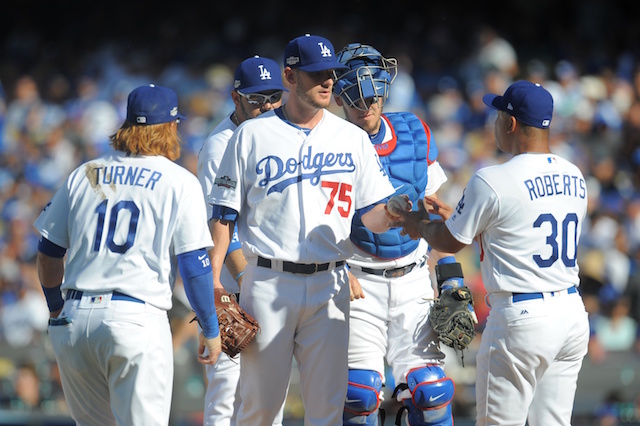Twelve months ago, no Dodger fan on the planet had ever heard of Grant Dayton. Today, the hopes and dreams of the 2017 Los Angeles Dodgers bullpen might lean heavily on the shoulders of Grant Dayton.
How did we get here?
In July 2015, the Dodgers designated Chris Reed — a former first-round draft pick — for assignment and merely hoped to get something for him. Fortunately, Los Angeles found a taker in the Miami Marlins (isn’t trading with them fun?), who sent along Dayton in exchange for Reed.
Dayton, you see, had been designated for assignment by the Marlins just a few months earlier. With no interest, he passed through waivers and was removed from Miami’s 40-man roster. At the time, Dayton had spent parts of two seasons in Triple-A with moderate success — albeit, for a 27-year-old (now 28).
Fast-forward to today, and Dayton is on the cusp of stardom depending on who you ask. According to the Steamer Projections, 10 relief pitchers are projected to provide 1.5 or more WAR this season.
Those pitchers (in order) are: Andrew Miller, Aroldis Chapman, Dellin Betances, Kenley Jansen, Zach Britton, Edwin Diaz, Wade Davis, Ken Giles, Grant Dayton and Craig Kimbrel.
Yes, according to Steamer, Dayton is projected to be the ninth-most valuable relief pitcher in all of baseball this season.
Just think about that for a second.
So while many debate the Dodgers’ need for a setup man, apparently some folks in the baseball world think the club’s bigger ‘problem’ is having two of the nine-best bullpen arms in the Majors.
But has the hype gone too far? Dayton has pitched in less than half of one Major League season thus far. Has he really proven enough to find himself in that vaunted company?
Consider the following four Dodgers relievers and how they fared to begin their careers:
Pitcher A: 27 IP, 12 H, 15 BB, 41 K, 2 ER (0.67 ERA, 1.00 WHIP, 1.82 FIP)
Pitcher B: 29.1 IP, 15 H, 10 BB, 33 K, 2 ER (0.61 ERA, 0.85 WHIP, 2.12 FIP)
Pitcher C: 61 IP, 33 H, 23 BB, 69 K, 15 ER (2.12 ERA, 0.92 WHIP, 3.08 FIP)
Pitcher D: 26.1 IP, 14 H, 6 BB, 39 K, 6 ER (2.05 ERA, 0.76 WHIP, 2.05 FIP)
All four obviously found great success to begin their careers. Pitcher A has the best strikeout rate, but the worst walk rate. Pitcher B has the best ERA, Pitcher C the most sustained success and Pitcher D the lowest WHIP and FIP of the bunch.
But does it mean anything?
Pitcher A has become one of the most dominant relievers in the baseball — Kenley Jansen.
Pitchers B and C, however, aren’t exactly Jansen-types. They are Adam Liberatore and Paco Rodriguez, respectively, and both, like Dayton, are also left-handers.
Pitcher D, then, is Dayton.
So yes, while Jansen found great success to begin his career — and then sustained it, the other two relievers started out brilliantly, only to falter as teams saw them more and more.
Liberatore (Pitcher B) is the perfect example. The numbers above are from the first half of last season, but in the second half he posted a 9.45 in just 13.1 innings. Granted, Liberatore suffered from multiple injuries and eventually underwent arthroscopic left elbow debridement.
Could it be that teams simply don’t have enough tape on Dayton yet? It’s possible.
But the good news for the Dodgers is many experts believe Dayton is destined for a career closer to Jansen’s than Rodriguez’s.
Some point to his success in the Minors in 2016, as amongst pitchers in Double-A or higher, Dayton trailed only Andrew Miller in K-BB percentage according to Jeff Sullivan of FanGraphs, while others look at the brilliance of Dayton’s fastball, which Daniel Brim of Dodgers Digest noted had the second-highest whiff/pitch rate.
Either way, Dayton has some believers in the world. And based on the Dodgers’ approach this offseason, it seems that confidence extends into the front office.
Yes, Sergio Romo’s one-year, $3 million contract is expected to be finalized, but the incentives-laden deal is hardly a deal breaker, nor guarantee that the right-hander will automatically be handed the setup role.
It sure seems like that is Dayton’s gig to lose. So, The Grant Dayton Hype Train is here. The question is: for how long?






